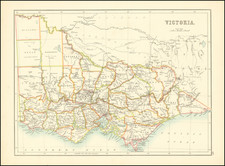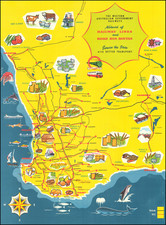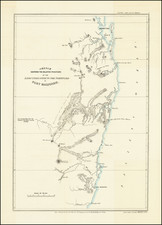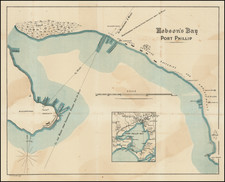Fine Early Map of Australia with Dutch Discoveries and Innovative Geographic Theories—Scarce Dutch Edition!
Nice Dutch-printed example of Bellin's map of Australia, which featured in the Abbe Prevost’s massive voyage collection, the Histoire générale des voyages. The map shows the latest information available about New Holland, as well as puts forth several theories about the still unknown coasts. It is one of the earliest collectable maps of Australia to not include the Asian continent or the rest of the world.
This Dutch edition, published in 1758, is scarcer than its French counterpart, published in 1753. The original was produced by Jacques Nicolas Bellin, the inaugural Ingénieur de la Marine of the Depot des cartes et plans de la Marine (the French Hydrographic Office). The map was augmented with several Dutch translations and a new title at the bottom by the engraver Jakob van der Schley, who operated out of Amsterdam.
The map provides a fine early depiction of Australia and shows the coastlines of myth and conjecture which began to form in the seventeenth century and were not fully explored until the early nineteenth century. The northern, western, and southern coastlines of the continent are delineated, but the southeastern and eastern coasts are conjectural. Van Diemen’s Land is still thought to be connected to the main Australian continent, a hypothesis not disproven until Flinders and Bass’s surveys in the 1790s.
The coastlines that are solidly drawn are based on seventeenth-century Dutch encounters with the Australian coast. For example, in the north is Terre d’Arnems, a reference to the Arnhem, a Dutch East India ship, which sighted the area in 1623. To the west is Terre de Wit, which recalls Gerrit Frederikszoon de Witt, captain of the Vianen, who sailed in 1628. To the west is Terre d’Endracht. The Endracht was the second recorded European ship to contact Australia (1616). Terre de Leuvin is named for the Leeuwin, whose crew charted some of the southwest coastline in 1622; Flinders would later name Cape Leeuwin, the southwestern most point on the Australian mainland, after the ship. Terre de Nuits is named for Pieter Nuyts, a Dutch navigator who commanded the Gulden Zeepaert along the southern coast in 1627.
Another conjectural coastline connects Carpentaria, in northeast Australia, to New Guinea. This was a holdover from two centuries of maps that exaggerated the size of New Guinea, but also Bellin’s own combination of other geographic chimeras. In reality, Luís Vaz de Torres, who sailed with Pedro Fernandes de Quiros in 1605, had passed through the straits between New Guinea and Australia. However, the Spanish had suppressed his report in the hopes of maintaining power via geographic secrecy and the Strait was only rediscovered by Alexander Dalrymple in 1762 when he was researching documents captured from the Spanish in the Philippines during the Seven Years’ War. Later, James Cook sailed through the Strait during his first voyage, confirming its existence to the Western world.
Here, Bellin has connected Van Diemen’s Land with the Australian eastern coast, but he has also attached Terre de St. Esprit. The land, Austrialia del Espiritu Santo was described as paradisiacal by Quiros when he landed there and tried to begin a colony in 1606. His crew forced him to leave, however, and the island was then shifted on maps by subsequent geographers to serve various cartographic hypotheses. Bellin writes, “Je suppose que la Terre de Diemen peut joindre avec la Terre de St. Esprit mais sans preuve" (I suppose that the land of Diemen could join with the land of the Holy Ghost but this is without proof). Bellin was correct to be skeptical of the connection he drew, for the islands Quiros landed at are now known as Vanuatu and are over one thousand miles from the Australian coast.
In the lower right corner, to the southeast, is the coast of New Zealand, which had not been contacted by Europeans since Tasman sailed there in 1642. Bellin suggests that the western coast sketched on his map might be part of a great continent that was antipodal to Europe in the South Seas. He was continuing a search for the southern continent that had lasted centuries and would not be dampened until Cook’s second voyage in the far southern Pacific proved that no such great continent existed.
This map was drawn by Bellin for the Abbe Prevost’ gigantic voyage collection. Antoine Francois Prevost (1697-1763) was a soldier, a priest, and a novelist. Fleeing after he left his abbey without leave, Prevost ended up in England. Later, he lived in The Hague (where he possibly met van der Schley) and, after reconciling with his religious order, in Chantilly, and, while in exile again, in Brussels and Frankfurt. From 1746 to 1759 he published the first fifteen volumes of the Histoire générale des voyages, which encompassed historical and recent voyages to destinations around the world. This map was in volume XI.
This map is highly original, with both received wisdom and new ideas. Additionally, it is one of the few eighteenth-century maps of Australia to not include Asia or the world. This Dutch edition is even rarer than its French counterparts. It is an essential map for collectors of the cartography of Australia.
Lawrence C. Wroth, “The Early Cartography of the Pacific,” The Papers of the Bibliographical Society of America 38, no. 2 (1944): 87-268.
Jakob van der Schley was a skilled draftsman and engraver who operated out of Amsterdam and had strong ties with the Hague. He was trained by Bernard Picart and his style resembles that of the elder man. Van der Schely was known for intricately engraved portraits and frontispieces. He signed most of the plates used in the Hague edition of the Abbe Prevost's Histoire generale des voyages.










![[ Tasmania / Hunter Island ] Carte des Iles Hunter dressee Par L. Freycinet, Commandant la Goelette le Casuarina, d'apres ses observations et celles de Mr. Boullanger Ingenieur Hydrographe -- December 1802. (Rare separately published example)](https://storage.googleapis.com/raremaps/img/small/53891.jpg)



